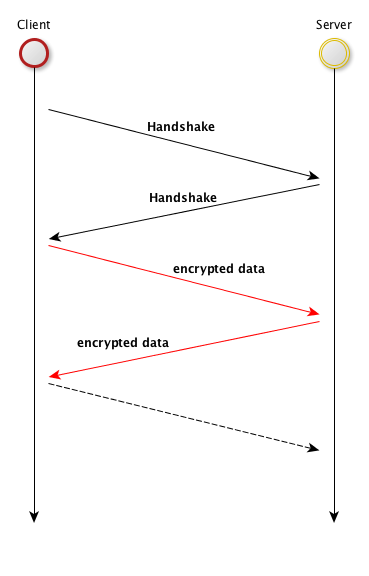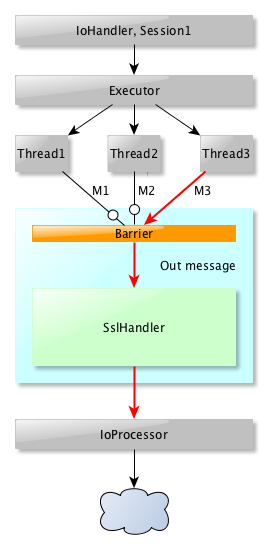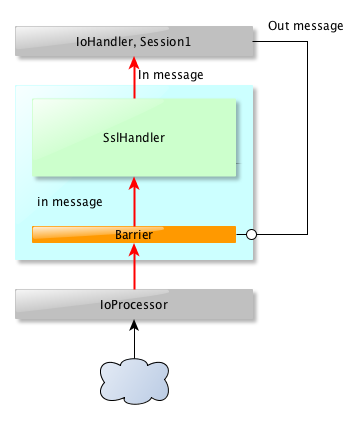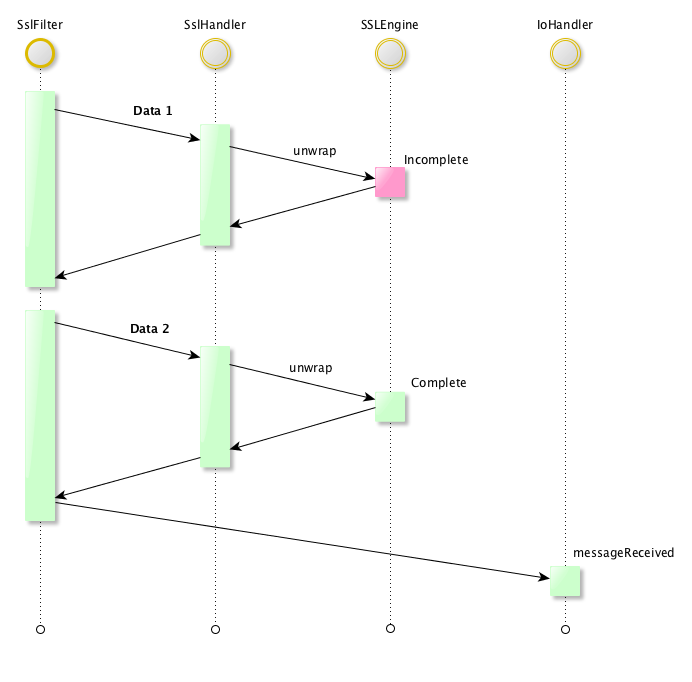Chapter 11 - SSL Filter
The SslFilter is the filter in charge of managing the encryption and decryption of data sent through a secured connection. Whenever you need to establish a secured connection, or to transform an existing connection to make it secure, you have to add the SslFilter in your filter chain.
As any session can modify it’s message filter chain at will, it allows for protocols like startTLS to be used on an opened connection.
Actually, TLS is supposed to have replaced SSL, but for historical reason, SSL remains widely used.
Basic usage
If you want your application to support SSL/TLS, just add the SslFilter in your chain :
...
DefaultIoFilterChainBuilder chain = acceptor.getFilterChain();
SslFilter sslFilter = new SslFilter(sslContext);
chain.addFirst("sslFilter", sslFilter);
...
You obviously need a SslContext instance too :
SSLContext sslContext;
try
{
// Initialize the SSLContext to work with our key managers.
sslContext = SSLContext.getInstance( "TLS" );
sslContext.init( ... ); // Provide the needed KeyManager[], TrustManager[] and SecureRandom instances
}
catch ( Exception e )
{
// Handle your exception
}
This is up to you to provide the KeyManager, TrustManager and SecureRandom instances.
Be sure to inject the SslFilter on the first position in your chain !
We will see later a detailed example on how to create a SSLContext.
A bit of theory
If you want to get a deeper understanding on how it all works, please read the following paragraphs…
SSL Basics
We are not going to explain how SSL works, there are very good books out there. We will just give a quick introduction on how it works and how it is implemented in MINA.
First of all, you have to understand that SSL/TLS is a protocol defined in RFCs : TLS 1.0, TLS 1.1, TLS 1.2 and RLS 1.3.
It was initially developed by Netscape, and named SSL (from 1.0 to 3.0), before becoming TLS. Nowadays, *SSL 2.0 and SSL 3.0 have been deprecated and should not be used.
The SSL/TLS protocol
As it’s a protocol, it requires some dialog between a client and a server. This is all what SSL/TLS is about : describing this dialog.
It’s enough to know that any secured exchange is precluded by a negotiation phase, called the Handshake, which role is to come to an agreement between the client and the server on what will be the encryption method to use. A basic SSL/TLS session will be something that looks like :

As you can see in this picture, it’s a 2 phases protocol : first the handshake, then when completed the client and the server will be able to exchange data that will be encrypted.
There are also other phases, like the SSL/TLS closure, or a renegotiation phase.
The Handshake
Basically, it’s all about negotiating many elements that are to be used to encrypt/decrypt the data. The details are not so interesting in the context of this document, enough said that many messages are going to be exchanged between the client and the server, and no data can be sent during this phase.
Actually, there are two conditions for the handshake to start :
- The server must be waiting for some handshake message to arrive
- The client must send a ClientHello message
We do use the Java SSLEngine class to manage the whole SSL/TLS protocol. What MINA should take care of is the current status of the session is such that it will be able to get and deal with the client HelloClient message. When you inject the SslFilter in your filter chain, a few things happen :
- A SslHandler instance is created (we create one instance per session). This SslHandler instance is in charge of the whole processing (handshake and encryption/decryption of forthcoming messages)
- This SslHandler creates a SSLEngine using the SslContext instance that has been attached to the SslFilter
- The SslEngine instance is configured and initialized
- The SslHandler instance is stored into the session
- Unless required specifically, we initiate the Handshake (which has different meanings on client side and on server side : the client will then send the ClientHello message, while the server switch to a mode where it waits for some data to be unwrapped). Note that the handshake initialization can be done later on, if needed
We are all set. The next few steps are pure SSL/TLS protocol exchange. If the session.write() method is called, the message will be enqueued waiting for the handshake to be completed. Any pending message at the time the SslFilter is added into the chain will cause the SSL/TLS handshake to fail, so be sure that you have a clean place when you want to inject it. We also won’t receive any message that is not a SSL/TLS protocol message.
This last point is important if you are to implement StartTLS : as it allows your application to switch from a plain text exchange to an encrypted exchange at any time, you have to be sure that there are not pending messages on both side. Obviously, on the client side - the side that initiates StartTLS - every pending messages will have been sent before the StartTLS message can be sent, but it has to block any other message that are not part of the following handshake, until the handshake is completed. On the server side, once the StartTLS message has been received, no message should be written to the remote peer.
As a matter of fact, injecting the SslFilter in the chain should block any exchange that are not part of the handshake protocol until the handshake is completed. If you submit a message to be sent and encrypted before the handshake has been completed, the message will not be rejected but queued and will be processed when the handshake has been completed.
Afterward, every message sent will go through the SslHandler instance to be encrypted, and every message received will have to be fully decrypted by the SslHandler before being available to the next filters.
Sending data
Ok, the Handshake has been completed. Your SslFilter is ready to process incoming and outgoing messages. Let’s focus on those your session are going to write.
One important thing is that you may write more than one message on the same session (if you have an Executor in your chain). The problem is that the SSLEngine is not capable of dealing with more than one message at a time. We need to serialize the messages being written out. It’s even worse : you can’t process an incoming message and and outgoing message at the same time.
All in all, the SSL/TLS processing is like a black box that accept only one input and can’t process anything until it has completed its task. the following schema represent the way it works for outgoing messages.

It’s not that different for incoming messages, except that we won’t have an Executor between the IoProcessor and the SslFilter. That makes things simpler, except that one critical thing happens : when we process an incoming message, we can’t anymore process outgoing messages. Note that it also works on the other way around : when an outgoing message is being processed, we can’t process an incoming message :

SSL/TLS in MINA 2
Now, we will dive a bit deeper into MINA code. We will cover all the filter operations:
- Management
- init()
- destroy()
- onPreAdd(IoFilterChain, String, NextFilter)
- onPostAdd(IoFilterChain, String, NextFilter)
- onPreRemove(IoFilterChain, String, NextFilter)
- onPostRemove(IoFilterChain, String, NextFilter)
- Session events
- sessionCreated(NextFilter, IoSession)
- sessionOpened(NextFilter, IoSession)
- sessionClosed(NextFilter, IoSession)
- sessionIdle(NextFilter, IoSession, IdleStatus)
- exceptionCaught(NextFilter, IoSession, Throwable)
- filterClose(NextFilter, IoSession)
- inputClosed(NextFilter, IoSession)
- Messages events
- messageReceived(NextFilter, IoSession, Object)
- filterWrite(NextFilter, IoSession, WriteRequest)
- messageSent(NextFilter, IoSession, WriteRequest)
Management
Here are the Filter’s management methods :
onPreAdd
This is where we create the SslHandler instance, and initialize it. We also define the supported ciphers.
The SslHandler instance will itself create an instance of SSLEngine, and configure it with all the parameters set in the SslFilter:
- If this is client or a server side
- When it’s server side, the flag that says we want or require the client authentication
- The list of enabled ciphers
- The list of enabled protocols
When it’s done, the reference to this instance is stored into the Session’s attributes.
onPostAdd
This is where we start the handshake if it’s not explicitly postponed. This is all what this method does. All the logic is implemented by the SslHandler
onPreRemove
Here, we stop the SSL session and we cleanup the session (removing the filter from the session’s chain and the SslHandler instance from the session’s attributes). The Sslhandler instance si also destroyed after having flushed any event that is not yet processed.
Session events
Here are the events that are propagated across the filter’s chain and processed by the SslFilter :
sessionClosed
We just destroy the SslHandler instance.
exceptionCaught
We have one special task to proceed when the exception is due to a closed session : we have to gather all the messages that were pending to add them to the exception that will be propagated.
filterClose
Here, if there is a SSL session started, we need to close it. In any case, we propagate the event into the chain to the next filter.
Messages events
Last, not least, the three events relative to messages :
messageReceived event
This event is received when we read some data from the socket. We have to take care of a few corner cases :
- The handshake has been completed
- The handshake has been started but is not completed
- No handshake has started, and the SslHandler is not yet initialized
Those three use cases are listed by order of frequency. Let’s see what is going to happen for each of those use cases.
The handshake has been completed
Good ! That means every incoming message is encapsulated in a SSL/TLS envelop, and should be decrypted. Now, we are talking about messages, but we actually receive bytes, that may need to be aggregated to form a full message (at least in TCP). If a message is fragmented, we will receive many buffers, and we will be able to decrypt it fully when we will receive the last piece. Remember that we are blocked during all the process, which can block the SslHandler instance for this session for quite some time…
In any case, every block of data is processed by the SslHandler, which delegates to the SslEngine the decryption of the bytes it received.
Here is the basic algorithm we have implemented in messageReceived() :
get the session's sslHandler
syncrhonized on sshHandler {
if handshake completed
then
get the sslHandler decrypting the data
if the application buffer is completed, push it into the message to forward to the IoHandler
else
enqueue the incoming data
}
flush the messages if any
The important part here is that the SslHandler will cumulate the data until it has a complete message to push into the chain. This may take a while, and many socket reads. The reason is that the SSLEngine cannot process a message unless it has all the bytes needed to decode the message fully.
The handshake has not been completed
The means the received message is part of the Handshake protocol. Nothing will be propagated to the IoHandler, the message will be consumed by the SslHandler.
Until the full handshake is completed, every incoming data will be considered as a Handshake protocol message.
At the same time, messages that the IoHandler will be enqueued, waiting for the Handshake to be completed.
Here is a schema representing the full process when the data are received in two round-trips :

filterwWrite event
This event is processed when the IoSession.write() method is called.
If the SSL session is not started, we simply accumulate the message to write. It will be send later.
We control the presence of the DISABLE_ENCRYPTION_ONCE flag in the session’s attributes, and if present, we remove it from the session, and push the message uncrypted into the messages queue to be send.
Otherwise, if the handshake is not yet completed, we keep the message in a queue, and if it’s completed, we encrypt it and schedule it to be written.
If some message has been scheduled for write, we flush them all.
messageSent event
Here, it’s just a matter of getting back the unencrypted message to propagate it to the IoHandler
SSLContext initialisation
We saw that in order to establish a SSL session, we need to create a SSLContext. Here is the code :
SSLContext sslContext;
try
{
// Initialize the SSLContext to work with our key managers.
sslContext = SSLContext.getInstance( "TLS" );
sslContext.init( ... ); // Provide the needed KeyManager[], TrustManager[] and SecureRandom instances
}
catch ( Exception e )
{
// Handle your exception
}
What we have not exposed here is the constructor and the init() method.
The SSLContext can either be created explicitly - through its constructor -, or we ask the static factory to return an instance (this is what we have done in the previous code. teh second method is quite straightforward, and would fit most of the time. It’s enough to pass it the name of the protocol to use, which is one of :
- SSL
- SSLv2
- SSLv3
- TLS
- TLSv1
- TLSv1.1
- TLSv1.2 (not supported in Java 6)
It’s strongly suggested to pick the higher algorithm (ie TLSv1.2) if your client supports it.
The init() method takes 3 arguments :
- a KeyManager (can be null)
- a TrustManager (can be null)
- a random generator (can be null)
If the parameters are set to null, the installed security provider will pick the highest priority implementation.